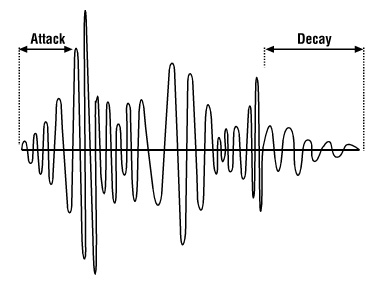attack

Figure 1. Attack and decay.

Figure 2. Attack of a piano note.
Attack is the initial period of a typical envelope during which a sound's attribute (such as volume) increases from 0 (silence) to its maximum amount. The length of the attack determines how soft or harsh a sound is. For example, most drum or percussion sounds have a short amplitude attack time and thus have a sudden "harsh" start. A string sound usually has a long amplitude attack and thus has a "soft" start and eases in. See also decay; ADSR.
Attack time may refer to:
Example: attack of a piano note
The start of a note must be heard if it is to be recognized. The graph in Figure 2 shows that a piano note, for example, reaches its peak volume very soon after it has been struck (A). It then begins to fall away with greater rapidity at first, before tailing away slowly for several seconds. This is what gives the instrument its attack. The same note produced on a gong takes a comparatively long time to build up and, although of the same pitch, sounds completely different. The same piano note played backwards on a tape recording (B) slowly increases in volume and then suddenly stops. Shorn of its start, the sound is totally unlike a piano and more like an organ.


